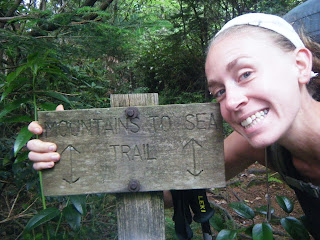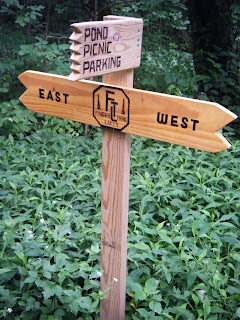 |
| The Sawkill Stream off of Schocopee Rd - rushing more heavily than usual after a storm the night before |
It has now been over two weeks since I stepped off the Finger Lakes Trail and back into the everyday world of eating whatever I please, sleeping in a bed and showering daily. However upon entering a convenience store I still immediately start scanning the countertops for their selection of condiment packages and the walls for possible outlets. There was also the night that I leapt into the center of my bed and swatted my poor cat in the face thinking she was some furry creature coming to get me in a lean-to. Ah... the transition. However, the most difficult transition....trail running just 3 miles a day and then sitting most of the rest of my hours. I miss the physical exertion. That and the literal tug on my heart that I feel on a warm day touched with a cool breeze or the view from my car of the early morning clouds hugging a mountain top or the sound of crickets chirping at night outside my window. I want to be out there...or rather in it...a part of my environment again rather than periodic visitor. I've been trying to ease the transition by getting out as much as possible and so I've been spending hours out under the stars at night and meandering through the woods here and there on some short hikes. However on a recent perfectly beautiful afternoon I finally had the opportunity to revisit my most beloved woods, those on Schocopee Road in Milford, PA, for the entire afternoon...
 |
| Bridge over the Sawkill Stream |
There's many trails, both cleared by man and trod by deer, that can lead you into these woods, owned partially by Peter Pinchot and the rest designated as the Delaware State Forest. However one of my preferred trails here is that one carved by the waters of the Sawkill Stream. Along Schocopee Rd there are two one-lane bridges that cross over this stream, making for perfect access points. I chose the first of these two and traveled upstream, walking the edges of the water through the ever-so-Pennsylvania rocky woods. Now that I am not thru-hiking I have the luxury of bringing with me as many field guides as I please, so I carried a guide to the ferns of the northeast, a guide to the mosses of the northeast, Newcomb's Wildflower guide, and a guide to the trees of the eastern United States. I was out not to do miles but to take my time with these woodland botanicals.
 |
| The peeling bark of Yellow Birch (Betula alleghaniensis) |
These woods are largely Eastern Hemlock (Tsuga canadensis), Yellow Birch (Betula alleghaniensis), Black Birch (Betula lenta), various Oaks (Quercus spp.) and Maples (Acer spp.). Streamside you are apt to find Witch Hazel (Hamamelis virginiana) with its branches bending ever closer to the water as well as Spice Bush (Lindera benzoin) with its fragrant leaves and red berries come fall. Basswood (Tilia spp.) is another likely friend sitting along the Sawkill, most readily identified by its large papery leaves with uneven leaf bases. However it is still the common Yellow Birch that repeatedly catches my eye, especially in northeastern woods. It's bark is silvery and peeling, many times providing a home to various mosses or fungi. Against the matte gray rock faces, it appears yellowish-silver or bronze and will often find a home growing in a shallow bowl of decomposing matter atop a giant boulder, snaking its roots to the forest floor below.
 |
| Roots of Yellow Birch (Betula alleghaniensis) |
If you snap of a small twig of Yellow Birch and scrape the outer bark you will notice a strong wintergreen scent. Although Black Birch (Betula lenta) is often considered more aromatic, I have at times found just the opposite to be true. This wintergreen quality is due to the methyl salicylates found in its bark which besides tasting good, also offer relief for muscular pains. Simply harvest a small branch and using a sharp knife, peel the bark until reaching the woody core. These peelings can then be used in making a medicinal decoction (a strong tea made of woody parts). Simply add 1 loose handful of bark to 16 oz of water and simmer for 20 minutes, keeping on the pot's lid cracked just enough to allow steam to release.
 |
| Leaves of Yellow Birch (Betula alleghaniensis) |
Its leaves are simple, alternate, sharply and many toothed, and often appear to grow in pairs from a mutual spur. These are also medicinal with anti-inflammatory and diuretic properties, however lacking in the strong wintergreen flavor. You can make an infusion (a strong tea made of vegetative parts) of the leaves by adding a handful to 16 oz hot water and allowing to steep for 10 minutes.
 |
| Common Polypody (Polypodium vulgare) |
Another boulder inhabitant is Common Polypody (Polypodium vulgare). I repeatedly find this fern in cool dark places whether that be in shaded rocky woods sitting amidst mosses, streamside, or growing from the crevices of glacially deposited boulders. Rock, water, shade. It is a relatively small fern, growing no longer than 12 inches and usually lesser. I think it bears a resemblance to Christmas Fern (Polystichum acrostichoides) however with a brighter green color and with leaflets that are completely attached to the center stalk rather than stocking shaped. Besides Common Polypody I also found Interrupted Fern (Osmunda calytoniana), Sensitive Fern (Onoclea sensibilis), Hay-Scented Fern (Dennstaedtia punctilobula), New York Fern (Thelypteris noveboracensis), Bracken Fern (Pteridium aquilinum), and Christmas Fern (Polystichum acrostichoides), and nearly everyone already bearing spores.
 |
| Spores of Common Polypody (Polypodium vulgare) |
Growing alongside the Yellow Birch and Common Polypody were three members of the Nettle family (Urticaceae), Clearweed (Pilea pumila), Wood Nettle (Laportea canadensis), and False Nettle (Boehmeria cylindrical), each easily distinguished from one another. It was a treat to have the opportunity to examine each of these plants literally side by side.
 |
| Wood Nettle (Laportea canadensis) in flower |
Wood Nettle is the only one traditionally deemed edible of the these three Nettles. Wood Nettle is one of my most frequently used wild edibles and if you've been following this blog for sometime you know that I encountered enormous patches of it along the Finger Lakes Trail. Because I've covered this plant a good amount in other posts (
http://thebotanicalhiker.blogspot.com/2011/06/nettles.html) I'll simply sum it up here by telling you that this is the nettle we all know well thanks to its stinging hairs and mistakenly refer to as the less common and non-native Stinging Nettle. The leaves of Wood Nettle are delicious when sautéed, steamed, baked or boiled. Contact with heat disarms its stinging hairs and leaves you with a tasty green high in Vitamins A and C. I particularly enjoy them in noodle dishes along the trail or pureed in a hummus when working with a full kitchen.
 |
| Clearweed (Pilea pumila) in flower - notice translucent stems |
Clearweed bears its common name because of its stems that become increasingly translucent with age. Unlike Wood Nettle, but similar to False Nettle, it does not bear any stinging hairs. Its leaves are also overall more rounded in shape with rounded teeth along their margins and bright green in color with 2 veins prominently visible running parallel to the midrib (center vein). This nettle can remain very small growing carpet-like in moist woods or reach 1 foot high, but never the height of Wood Nettle or False Nettle. I have read in numerous sources that this nettle is edible but unpalatable so I have always passed on the same information to my students. However, I decided I'd try it for myself! I chowed an entire mature leaf and found that its taste was not really all that unpleasant. I can't say that it was delicious, but if anything it was merely lacking in flavor. Something to bear in mind when considering wild foods for survival.
 |
| Flower clusters of False Nettle (Boehmeria cylindrica) |
False Nettle is most easily discerned from these first two nettles by its button shaped clusters of green flowers located in axils and along leaf stalks. Its leaves are nearly identical in all characteristics to those of Wood Nettle except that they are opposite. This entire plant is lacking in stinging hairs. I have done some research on this plant and cannot find any information regarding its edibility except that it is not considered a plant with edible parts. However I also did not find anything stating that it was toxic or poisonous. If any of my readers have any further information about this plant's edibility I'd be thrilled to receive it!
 |
| A waterfall along the Sawkill and home to all the aforementioned plants |
I followed the Sawkill further, passing numerous waterfalls and plant communities similar to those I've describe above. Further from the water, amongst the damp leaf matter and thick ferns I passed White Snakeroot (Eupatorium maculatum), Cinquefoil (Potentilla spp.), White Wood Aster (Aster divaricatus), and Rough Bedstraw (Galium asprellum) as well as a host of Violet (Viola) leaves.
 |
| White Snakeroot (Eupatorium maculatum) |
 |
| White Wood Aster (Aster divaricatus) |
And after sometime the landscape began to change. The understory vegetation became thicker and more difficult to navigate while at the same time the trees thinned. I was reaching the swamp located at a sharp bend in the stream. Beavers, which have now been removed from the area, changed an entire ecosystem, creating a beautiful expanse of marshland but also killing a host of trees and inadvertently encouraging the growth of understory bushes such as Sweet Fern (Comptonia peregrina), Highbush (Vaccinium corymbosum) and Lowbush Blueberry (Vaccinium angustifolium), and ferns galore.
 |
| Swamp along the Sawkill Stream |
Growing in the tall grasses and shrubbery of the swamps edge I came upon the flowers of Rough Stemmed Goldenrod (Solidago rugosa) just beginning, clearly a later flowering species than that of Sweet Goldenrod (Solidago odora) or Grass Leaved Goldenrod (Solidago graminifolia). And near the deepest waters, I spied Cardinal Flower (Lobelia cardinalis) peeking its many red faces from the thick tufts of marsh grass.
 |
| Rough Stemmed Goldenrod (Solidago rugosa) |
 |
| Hairy stems of Rough Stemmed Goldenrod (Solidago rugosa) |
 |
| Cardinal Flower (Lobelia cardinalis) |
With the sun now at 5:00 in the sky it was time to turn it around. It had taken me 3 hours to walk what was very likely about 1.5 miles. To follow the same route back, although I'd move faster I'd still have to walk its rocky embankments, stepping stones here and there as necessary and climbing its sometimes steep sloping sides. I didn't have the time or the energy for that, so instead I decided to wade across the stream where it zig-zagged through the marsh and it was no more than knee-deep. Once on the other side, I picked up a trail that has been recently cut in the last year and provides for easy terrain. After about another mile through these sun-dappled woods, I reached the road that would lead me back to the bridge where I'd entered the woods earlier in the day. With the breeze now even cooler and the sun quickly turning an early evening golden, I closed my eyes and turned my face to the sky as I walked...filled with a deep down happy to have once again returned home.
































































